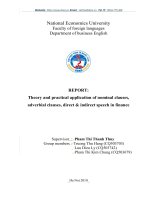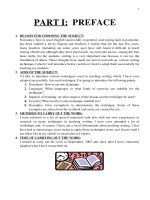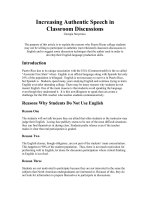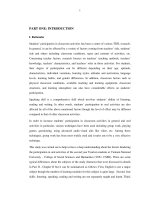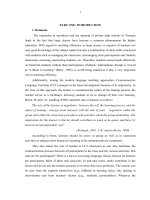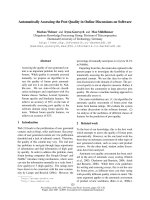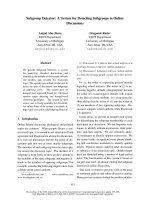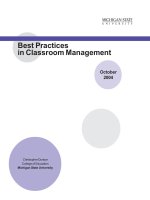Increasing Authentic Speech in Classroom Discussions
Bạn đang xem bản rút gọn của tài liệu. Xem và tải ngay bản đầy đủ của tài liệu tại đây (69.06 KB, 4 trang )
Increasing Authentic Speech in Classroom
Discussions
Georgia Smyrniou
The purpose of this article is to explain the reasons why Puerto Rican college students may
not be willing to participate in authentic (not rehearsed) classroom discussions in English
and to suggest some discussion techniques that the author used in order to develop their
English language production skills.
Introduction
Puerto Rico due to its unique association with the USA (Commonwealth) is the so called
"Associate Free State” where English is an official language along with Spanish but only
10% of the population is bilingual. English is not necessary to survive in Puerto Rico, but
Spanish is. Students spend many years studying English and continue trying to learn
English even after attending college. There may be many reasons why students do not
master English. One of the main reasons is that students avoid speaking the language even
though they understand it. It is this unwillingness to speak that can create a challenge for
the ESL teacher who teaches students communicatively.
Reasons Why Students Do Not Use English
Reason One
The students will not talk because they are afraid that other students or the instructor may
judge their English. Losing face publicly seems to be one of the most difficult situations
they can find themselves in during class. Students prefer silence even if the teacher makes
it clear that oral participation is graded.
Reason Two
The English classes, though obligatory, are not part of the students’ main concentration.
This happens to 90% of the student population. Thus, there is not much motivation for
performing well in English, let alone for discussion participation where critical thinking in
English is involved.
Reason Three
Students are not motivated to participate because they are not interested in the same the
subjects that North American undergraduates are interested in. Because of this, they do not
look for information to prepare themselves to participate in discussions.
Techniques Working as Solutions
1. Checking the Culture
I will start with the third reason because it seemed to be easier than the other two to
overcome. In order to understand what students like to talk about I started observing the
culture, particularly watching the types of materials the media were employing to promote
their publications or broadcasts. I detected five main social categories, which Puerto Rican
people liked to discuss, and tried them in class. The categories were:
• Religion
• Politics (particularly the issue of Puerto Rican statehood)
• The war of the sexes
• Family
• Traditional Latin American art expressions (music, dance and singing)
In addition, from the students’ culture I found that they like:
• Special types of cartoons and
• Science fiction.
The topics were announced a week ahead so that the students would have the opportunity
to prepare. Students started relating to the topics and thus participated without having to be
prodded. Although it was true that the participation was getting better and the students
started talking to each other (student centered discussion), many students were not
gathering information to prepare them to contribute to the discussion. Though they wanted
to participate, their personal opinions were not well thought out and not based on facts.
2. Using Search Engines
Knowing that the students like to use computers to play games, I showed them how to use
search engines to find information on the Web and copy it to a floppy disk and at the same
time keep a window open with a game they wanted to play. If they got tired of reading the
information, they could go back to the game and later continue to read the information
again. The rule was that they would have to find at least two web sites with information
before the class time finished and email me the URLs. A particular day of the week was
dedicated to using the computer lab and doing their searches. Eventually, the searches took
more time and the game pages remained idle for most of the class time. There were some
students who preferred to check email and play without searching. Through the lab’s
network I could locate these students and send a notice to their screens. If this behavior
were repeated during the class time, I would blank out their screens. Blanking out of the
screens a second time meant the student would be counted absent that day.
3. Reviewing the Information
The next step was to have students read the information they found. I would explain that a
maximum of a two-page review had to be submitted regarding the information they found
on the Internet, written in their own words. The pages had to be submitted before the day
on which the discussion would be held. The URLs were included on the pages so that I
could check them and compare them with the reviews that they had submitted.
4. Finding Arguments Based On the Reviews
On the day of the discussion, I would return the information, I would split them into groups
and I would give the students up to15 minutes to find arguments in favor and against the
particular topic based on the reviews they had prepared. After the students had created the
arguments, I would once more gather the review papers so that they would not be read
during the discussion. If anybody exceeded 15 minutes for arguments, a strike would go
against his/her group. This was done to assure that the information had been read at home
before coming to class. If the students had read the information before the class, they
would be able to quickly find arguments. If they had not personally done the report, it
would become obvious from the slow pace they would follow in class to establish such
arguments and the problem they had in locating the information in the report they had
submitted.
Did it work? At the beginning it was difficult for the students to adjust to the new
information media and I felt a bit of policing was necessary. However, the discussions
started getting better and I felt worth doing it. By “better” I mean that I had spontaneous
(authentic) speech production in English. The students were not trying to tailor a good
sounding argument just for the sake of speaking English. They were interested in the topic.
This was very important to me since I was using communicative competence methods
where the classroom tries to simulate a real situation even if the English was not always
grammatically accurate. Still the students could communicate their messages and be
understood.
5. Using Online Chat to Increase Speech Production
How to overcome the problem stated in reason number one was the biggest challenge. It is
true that personality and culture can affect learning. This time I looked into my training in
educational technology for help. I started experimenting by putting material of the course
on line using Web Course Tools (WebCT). One day of the week the class would meet in
its chat rooms and we would talk. Another day of the week we would do the discussion in
class. Due to the fact that WebCT provides recordings of the discussions, I could ask the
students in the classroom to elaborate on points that were not fully covered in the chat.
Since even the shyest would contribute to the WebCT chat, I could always ask them to
elaborate on comments they made or were made to them when on line. The discussions
had actually turned into good reflective discussions (they involve synthesis and analysis)
by the end of the semester.
Also, from the moment I decided to use online chat, the classroom dynamics started
changing. Somehow getting to know each other in the chat room and writing to each other
in English (the Spanish language option had been disabled) and maybe not having to
encounter the instructor face to face in the chat, gave them the feeling of control over the
online discussions and more confidence in the classroom discussions.
During the online discussions the students would soon forget about me and would address
each other. In fact the amount of language production in the chat was bigger than in class.
Since I was aiming at speech production and not written production I had to be online and
in the classroom, using the online writing production to motivate the classroom speech
production.
Conclusion
By introducing the above problems and solutions I hope to draw the attention to how
culture sensitive discussions can be, how this sensitivity can be related to speech
production and how concentration can play a role on students’ motivation to participate in
these discussions. I would also like to emphasize how educational technology can be used
as a means of facilitating students’ preparation for discussion and students’ speech
production in the classroom.
